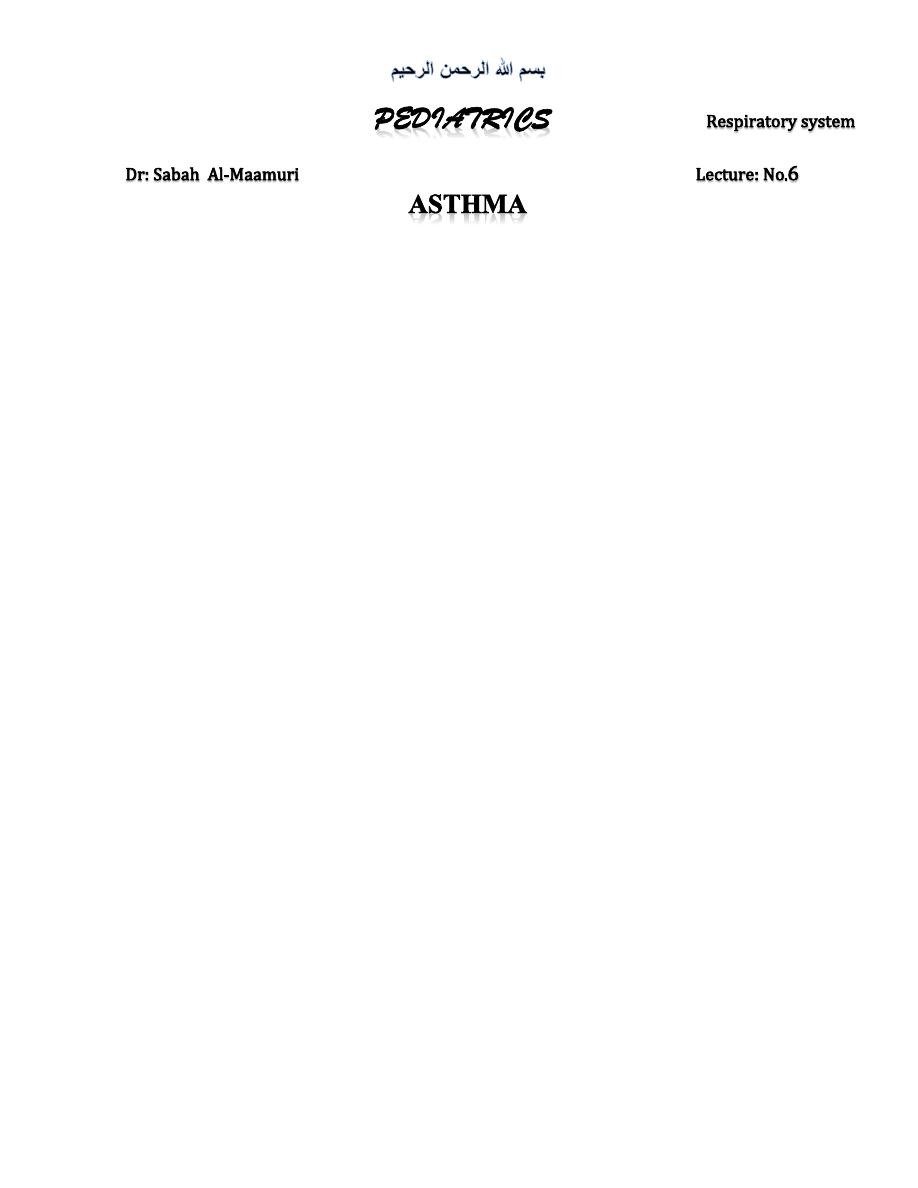
1
Asthma is a chronic inflammatory condition of the lung airways resulting in episodic airflow obstruction. This
chronic inflammation heightens the twitchiness of the airways—airways hyper responsiveness (AHR)—to
provocative exposures. Asthma management is aimed at reducing airways inflammation by minimizing
proinflammatory environmental exposures, using daily controller anti-inflammatory medications, and controlling
co-morbid conditions that can worsen asthma. Less inflammation typically leads to better asthma control, with
fewer exacerbations and decreased need for quick-reliever asthma medications. Nevertheless, exacerbations can
still occur. Early intervention with systemic corticosteroids greatly reduces the severity of such episodes.
Advances in asthma management and, especially, pharmacotherapy enable all but the uncommon child with severe
asthma to live normally.
Etiology
Although the cause of childhood asthma has not been determined, contemporary research implicates a combination
of environmental exposures and inherent biologic and genetic vulnerabilities. Respiratory exposures in this causal
environment include inhaled allergens, respiratory viral infections, and chemical and biologic air pollutants such
as environmental tobacco smoke. In the predisposed host, immune responses to these common exposures can be a
stimulus for prolonged, pathogenic inflammation and aberrant repair of injured airways tissues. Lung dysfunction
(i.e., AHR and reduced airflow) develops. These pathogenic processes in the growing lung during early life
adversely affect airways growth and differentiation, leading to altered airways at mature ages. Once asthma has
developed, ongoing exposures appear to worsen it, driving disease persistence and increasing the risk of severe
exacerbations.
Genetics
More than 100 genetic loci have been linked to asthma. Although the genetic linkages to asthma have sometimes
differed between cohorts, asthma has been consistently linked with loci containing proallergic, proinflammatory
genes (the interleukin [IL]-4 gene cluster on chromosome 5). Genetic variation in receptors for different asthma
medications is associated with variation in biologic response to these medications (polymorphisms in the β2-
adrenergic receptor). Other candidate genes include ADAM-33 (member of the metalloproteinase family), the
gene for the prostanoid DP receptor, and genes located on chromosome 5q31 (possibly IL-12)
Environment
Recurrent wheezing episodes in early childhood are associated with common respiratory viruses, including
respiratory syncytial virus, rhinovirus, influenza virus, adenovirus, parainfluenza virus, and human
metapneumovirus. This association implies that host features affecting immunologic host defense, inflammation,
and the extent of airways injury from ubiquitous viral pathogens underlie susceptibility to recurrent wheezing in
early childhood. Furthermore, injurious viral infections of the airways that manifest as pneumonia or bronchiolitis

2
requiring hospitalization are risk factors for persistent asthma in childhood. Other airways exposures can also
exacerbate ongoing airways inflammation, increase disease severity, and drive asthma persistence. Indoor and
home allergen exposures in sensitized individuals can initiate airways inflammation and hypersensitivity to other
irritant exposures, and are strongly linked to disease severity and persistence. Consequently, eliminating the
offending allergen(s) can lead to resolution of asthma symptoms and can sometimes “cure” asthma. Environmental
tobacco smoke and air pollutants (ozone, sulfur dioxide) aggravate airways inflammation and increase asthma
severity. Cold dry air and strong odors can trigger bronchoconstriction when airways are irritated but do not
worsen airways inflammation or hyper responsiveness.
Epidemiology
Asthma is a common chronic disease, causing considerable morbidity.
Nearly 60% of those with current asthma,
had experienced at least one asthma attack in the prior year. Boys (14% vs 10% girls) and children in poor families
(16% vs 10% not poor) are more likely to have asthma.
Worldwide, childhood asthma appears to be increasing in
prevalence, despite considerable improvements in our management and pharmacopeia to treat asthma.
Worldwide,
childhood asthma appears to be increasing in prevalence,
the prevalence of current wheeze, 0.8-37.6%.
Approximately 80% of all asthmatic patients report disease onset prior to 6 yr of age. However, of all young
children who experience recurrent wheezing, only a minority goes on to have persistent asthma in later childhood.
Prediction of asthma includes major (parent asthma, eczema, inhalant allergen sensitization) and minor (allergic
rhinitis, wheezing apart from colds, ≥4% eosinophil, food allergen sensitization) risk factors. Allergy in young
children has emerged as a major risk factor for the persistence of childhood asthma.
CHILDHOOD RISK FACTORS FOR PERSISTENT ASTHMA
Parental asthma
Allergy:
Atopic dermatitis (eczema
(
Allergic rhinitis
Food allergy
Inhalant allergen sensitization
Food allergen sensitization
Severe lower respiratory tract infection:
Pneumonia
Bronchiolitis requiring hospitalization
Wheezing apart from colds
Male gender
Low birth weight
Environmental tobacco smoke exposure
Possible use of acetaminophen (paracetamol)
Exposure to chlorinated swimming pools:
Reduced lung function at birth
Types of Childhood Asthma
There are 2 main types of childhood asthma:
(1) Recurrent wheezing in early childhood, primarily triggered by common viral infections of the respiratory tract.

3
(2) Chronic asthma associated with allergy that persists into later childhood and often adulthood.
A 3rd type of childhood asthma typically emerges in females who experience obesity and early-onset puberty (by
11 yrs. of age).
Pathogenesis
Airflow obstruction in asthma is the result of numerous pathologic processes. In the small airways, airflow is
regulated by smooth muscle encircling the airways lumens; bronchoconstriction of these bronchiolar muscular
bands restricts or blocks airflow. A cellular inflammatory infiltrate and exudates distinguished by eosinophils, but
also including other inflammatory cell types (neutrophils, monocytes, lymphocytes, mast cells, basophils), can fill
and obstruct the airways and induce epithelial damage and desquamation into the airways lumen. Helper T
lymphocytes and other immune cells that produce proallergic, proinflammatory cytokines (IL-4, IL-5, IL-13), and
chemokine's (exotoxins) mediate this inflammatory process. Pathogenic immune responses and inflammation may
also result from a breach in normal immune regulatory processes (such as regulatory T lymphocytes that produce
IL-10 and transforming growth factor [TGF]-β) that dampen effector immunity and inflammation when they are
no longer needed. Hypersensitivity or susceptibility to a variety of provocative exposures or triggers can lead to
airways inflammation, AHR, edema, basement membrane thickening, sub epithelial collagen deposition, smooth
muscle and mucous gland hypertrophy, and mucus hyper secretion—all processes that contribute to airflow
obstruction .
ASTHMA TRIGGERS
Common viral infections of the respiratory tract
Aeroallergens in sensitized asthmatic patients :
Animal dander
Indoor allergens
Dust mites
Cockroaches
Molds
Seasonal aeroallergens :
Pollens (trees, grasses, weeds)
Seasonal molds
Environmental tobacco smoke
Air pollutants :
Ozone
Sulfur dioxide
Particulate matter
Wood- or coal-burning smoke
Endotoxin, mycotoxins
Dust
Strong or noxious odors or fumes :
Perfumes, hairsprays
Cleaning agents
Occupational exposures :

4
Farm and barn exposures
Formaldehydes, cedar, paint fumes
Cold air, dry air
Exercise
Crying, laughter, hyperventilation
Co-morbid conditions :
Rhinitis
Sinusitis
Gastro esophageal reflux
Clinical Manifestations
Intermittent dry coughing and expiratory wheezing are the most common chronic symptoms of asthma. Older
children and adults report associated shortness of breath and chest tightness; younger children are more likely to
report intermittent, non-focal chest pain. Respiratory symptoms can be worse at night, especially during prolonged
exacerbations triggered by respiratory infections or inhalant allergens. Daytime symptoms, often linked with
physical activities or play, are reported with greatest frequency in children. Other asthma symptoms in children
can be subtle and nonspecific, including self-imposed limitation of physical activities, general fatigue (possibly
due to sleep disturbance), and difficulty keeping up with peers in physical activities. Asking about previous
experience with asthma medications (bronchodilators) may provide a history of symptomatic improvement with
treatment that supports the diagnosis of asthma. Lack of improvement with bronchodilator and corticosteroid
therapy is inconsistent with underlying asthma and should prompt more vigorous consideration of asthma-
masquerading conditions.
Asthma symptoms can be triggered by numerous common events or exposures
The presence of risk factors, such as a history of other allergic conditions (allergic rhinitis, allergic conjunctivitis,
atopic dermatitis, food allergies), parental asthma, and/or symptoms apart from colds, supports the diagnosis of
asthma. During routine clinic visits, children with asthma commonly present without abnormal signs, emphasizing
the importance of the medical history in diagnosing asthma. Some may exhibit a dry, persistent cough. The chest
findings are often normal. Deeper breaths can sometimes elicit otherwise undetectable wheezing. In clinic, quick
resolution (within 10 min) or convincing improvement in symptoms and signs of asthma with administration of a
short-acting inhaled β-agonist (SABA; e.g., albuterol) is supportive of the diagnosis of asthma.
During asthma exacerbations, expiratory wheezing and a prolonged expiratory phase can usually be appreciated by
auscultation. Decreased breath sounds in some of the lung fields, commonly the right lower posterior lobe, are
consistent with regional hypoventilation owing to airways obstruction. Crackles (or rales) and rhonchi can
sometimes be heard, resulting from excess mucus production and inflammatory exudate in the airways. The
combination of segmental crackles and poor breath sounds can indicate lung segmental atelectasis that is difficult
to distinguish from bronchial pneumonia and can complicate acute asthma management. In severe exacerbations,
the greater extent of airways obstruction causes labored breathing and respiratory distress, which manifests as
inspiratory and expiratory wheezing, increased prolongation of exhalation, poor air entry, suprasternal and
intercostal retractions, nasal flaring, and accessory respiratory muscle use. In extremis, airflow may be so limited
that wheezing cannot be heard

5
Differential Diagnosis
Many childhood respiratory conditions can present with symptoms and signs similar to those of asthma.
Besides asthma, other common causes of chronic, intermittent coughing include gastro esophageal reflux (GER)
and rhino sinusitis. Both GER and chronic sinusitis can be challenging to diagnose in children. Often, GER is
clinically silent in children, and children with chronic sinusitis do not report sinusitis-specific symptoms, such as
localized sinus pressure and tenderness. In addition, both GER and rhino sinusitis are often co-morbid with
childhood asthma and, if not specifically treated, may make asthma difficult to manage.
DIFFERENTIAL DIAGNOSIS OF CHILDHOOD ASTHMA
UPPER RESPIRATORY TRACT CONDITIONS
Allergic rhinitis
Chronic rhinitis
Sinusitis
Adenoidal or tonsillar hypertrophy
Nasal foreign body
MIDDLE RESPIRATORY TRACT CONDITIONS
Laryngotracheobronchomalacia
Laryngotracheobronchitis (e.g., pertussis)
Laryngeal web, cyst, or stenosis
Vocal cord dysfunction
Vocal cord paralysis
Tracheoesophageal fistula
Vascular ring, sling, or external mass compressing on the airway (e.g., tumor)
Foreign body aspiration
Chronic bronchitis from environmental tobacco smoke exposure
Toxic inhalations
LOWER RESPIRATORY TRACT CONDITIONS
Bronchopulmonary dysplasia (chronic lung disease of preterm infants)
Viral bronchiolitis
Gastro esophageal reflux
Causes of bronchiectasis:
Cystic fibrosis
Immune deficiency
Allergic bronchopulmonary mycoses (e.g., aspergillosis(
Chronic aspiration
Immotile cilia syndrome, primary ciliary dyskinesia
Bronchiolitis obliterans
Interstitial lung diseases
Hypersensitivity pneumonitis

6
Pulmonary eosinophilia, Churg-Strauss vasculitis
Pulmonary hemosiderosis
Tuberculosis
Pneumonia
Pulmonary edema (e.g., congestive heart failure)
Medications associated with chronic cough:
Acetyl cholinesterase inhibitors
Β-Adrenergic antagonists
Angiotensin-converting enzyme inhibitors
Diagnosis
The diagnosis depends on the clinical presentations + laboratory findings.
Lung functions tests
Measuring of the expiratory air flow is helpful in the diagnosis, monitoring & assessing the efficacy of treatment.
a) Spirometer (usually for children >6 yrs.): It measures FEV1 (forced expiratory volume in 1 second) & FVC
(forced vital capacity). It also assesses the "bronchodilator response" using inhaled B-agonist, the "exercise
challenge", & the "bronchoprovacation challenges" using methacoline, histamine, or cold & dry air which is rarely
used.
b) Peak expiratory flow (PEF) monitoring : It is a simple & inexpensive home used tool to measure the peak
expiratory flow (PEF).
Lung functions abnormality in asthma
Spirometer
1. Air flow limitation (↓FEV1, FEV1 / FVC ratio < 0.8)
2. Bronchodilator response →improvement in FEV1 ≥12%
3. Exercise response →worsening in FEV1 ≥15%
PEF morning to afternoon variability ≥20%
Radiology
CXR may be normal apart from the hyperinflation.
Subtle and nonspecific findings of hyperinflation (flattening of the
diaphragms) and per bronchial thickening
There may be a features of complications & sometimes CT-scan can be
used (e.g. bronchiectasis).
Others
As allergy testing & IgE level may help in the management & prognosis.
In severe exacerbation: blood gas analysis, blood PH.
Classification of asthma severity
1. Acute exacerbation: It is classified into 3 grades : mild, moderate, & severe acute attack (exacerbation)
according to the following parameters : PEFR, PR, Alertness, Dyspnea, Pulsus paradoxus, Accessory muscle use,
Color, Auscultation, O2 saturation, & PCO2.
2. Chronic asthma: It is classified into 4 grades : Mild intermittent asthma, Mild persistent asthma, Moderate
persistent asthma, & Severe persistent asthma according to the following variables : Daytime symptoms,
Nocturnal symptoms, Exacerbations, Lung functions, & B-agonists use.

7
Asthma medications
1. Quick-relief medications (relievers)
Short-acting inhaled B-agonists: as albuterol (ventolin) & terbutaline.
Inhaled anticholinergic: as ipratropium bromide & atropine.
Short course systemic glucocorticoids: as prednisone & methylprednisolone.
2. Long term-control medications (controllers)
NSAI agents: as cromolyn & nedocromil.
Inhaled glucocoricoids : as beclomethasone & budesonide.
Sustained-release theophylline.
Long-acting inhaled B-agonists (LABA S): as salmetrol.
Leukotriene modifiers: as monteleukast & zafirleukast.
Oral glucocorticoids: as prednisone & methylprednisolone.
Management
Management of the acute attack (exacerbation)
Mild attack can be treated at home.
Indications of hospital admission
1. Moderate-severe attack which does not improve within 1-2 hrs of initial treatment.
2. Prolonged symptoms before admission.
3. Inadequate access to the medical care & medications.
4. Difficult psychological conditions.
5. Difficulty in obtaining transportation to the hospital in event of further deterioration.
Home management
Immediate inhaled short acting B-agonist (up to 3 times / 1 hr.).
Good response is characterized by: resolution of symptoms in 1 hr., no further symptoms over the next 4
hrs. & improvement of PEF of 80% predicted or personal best.
If the child has incomplete response to B-agonist (i.e. persistent symptoms &/or PEF of 60-80% of
predicted or personal best) →short course of oral glucocorticoids (e.g. prednisone 1-2 mg/kg/day for 4
days) in addition to inhaled B-agonist.
Hospital management
O2 administration.
Close monitoring of the clinical status.
Inhaled short acting B-agonist (every 20 min. for 1 hr.).
If necessary, systemic glucocorticoids (prednisolone 2 mg/kg/day oral or IV). [NAEPP recommends the
use of methylprednisolone at 1 mg/kg/dose every 6 hrs. for 2 days then ↓ dose to1-2 mg/kg/day in 2
divided doses until PEF reaches 70% of predicted or personal best. This is especially useful in the very
severe attacks of asthma].
Inhaled ipratropium bromide may be added to B-agonist if no significant response is seen with 1st inhaled
B-agonist.
Subcutaneous epinephrine may be given in severe cases.
IV fluid may be given in persistent severe dyspnea (slightly below maintenance due to ↑ ADH).

8
In status asthmatics , the following options may be added
1. Intubation & mechanical ventilation.
2. IV B-agonist, IV theophylline.
3. Inhaled Heliox (Helium & O2).
4. IV Mg sulfate (smooth muscle relaxant).
Patient may be discharged home if there are
1. Sustained improvement in symptoms.
2. Normal physical findings.
3. PEF > 70% of predicted or personal best.
4. O2 saturation > 92% on room air for 4 hrs.
Discharge therapy includes inhaled B-agonist (up to ever 3-4 hrs.) + glucocorticoids (3-7 days course of
prednisolone).
Management of chronic asthma
1. Mild intermittent asthma
There is no continuous daily treatment but inhaled short acting B-agonist can be used when there are
symptoms or as prophylactic therapy for exercises.
Daily treatment with a " controller " drug is recommended for all 3 types of persistent asthma :
2. Mild persistent asthma
Low-dose inhaled glucocorticoid
Inhaled cromolyn
Leukotriene modifier
[Sustained-release theophylline ( as alternative)].
3. Moderate persistent asthma
Medium-dose inhaled glucocorticoid
Low-dose inhaled glucocorticoid + either LABA inhaler or leukotrien modifier, or [Sustained-release
theophylline or LABA tab.(as alternative)].
4. Severe persistent asthma
High-dose inhaled glucocorticoid + either LABA inhaler or leukotrien modifier, or [sustained-release
theophylline or LABA tab. (as alternative)] +
Oral glucocorticoid (if needed).
Prognosis
Recurrent coughing and wheezing occurs in 35% of preschool-aged children. Of these, approximately one third
continue to have persistent asthma into later childhood, and approximately two thirds improve on their own
through their teen years. Asthma severity by the ages of 7-10 yrs. of age is predictive of asthma persistence in
adulthood. Children with moderate to severe asthma and with lower lung function measures are likely to have
persistent asthma as adults. Children with milder asthma and normal lung function are likely to improve over time,
with some becoming periodically asthmatic (disease-free for months to years); however, complete remission for 5
yrs. in childhood is uncommon.

9
Prevention
Several non pharmacotherapeutic measures with numerous positive health attributes—avoidance of environmental
tobacco smoke (beginning prenatally), prolonged breastfeeding (>4 mo.), an active lifestyle, and a healthy diet—
might reduce the likelihood of asthma development. Immunizations are currently not considered to increase the
likelihood of development of asthma; therefore, all standard childhood immunizations are recommended for
children with asthma, including varicella and annual influenza vaccines.
